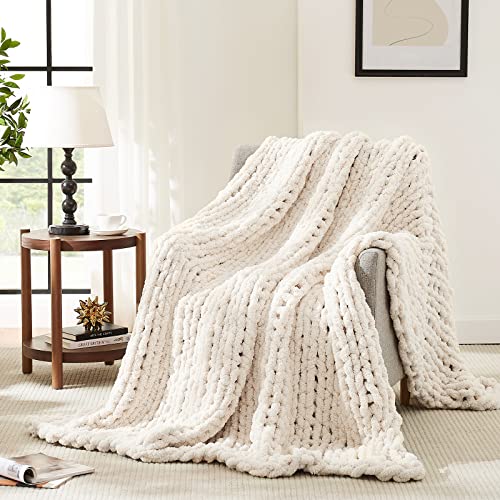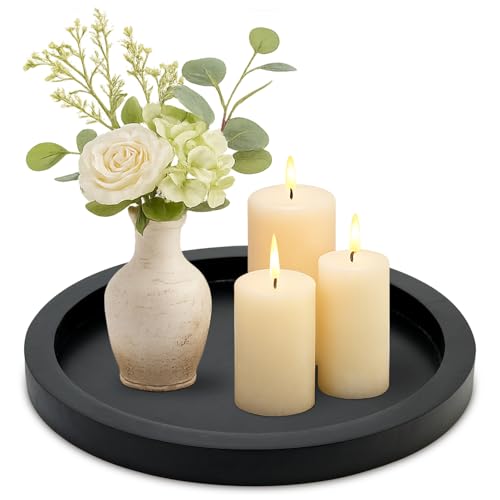
For bibliophiles, the living room transcends mere gathering space—it becomes a sanctuary where literature breathes life into design. These 33 stunning examples demonstrate how book collections can elevate interiors from functional to extraordinary, merging intellectual passion with aesthetic excellence. Each space celebrates the transformative power of surrounding ourselves with stories, creating environments that nourish both mind and soul.
In order to come up with the very specific design ideas, we create most designs with the assistance of state-of-the-art AI interior design software.
Living Room with Floor-to-Ceiling Book Shelves
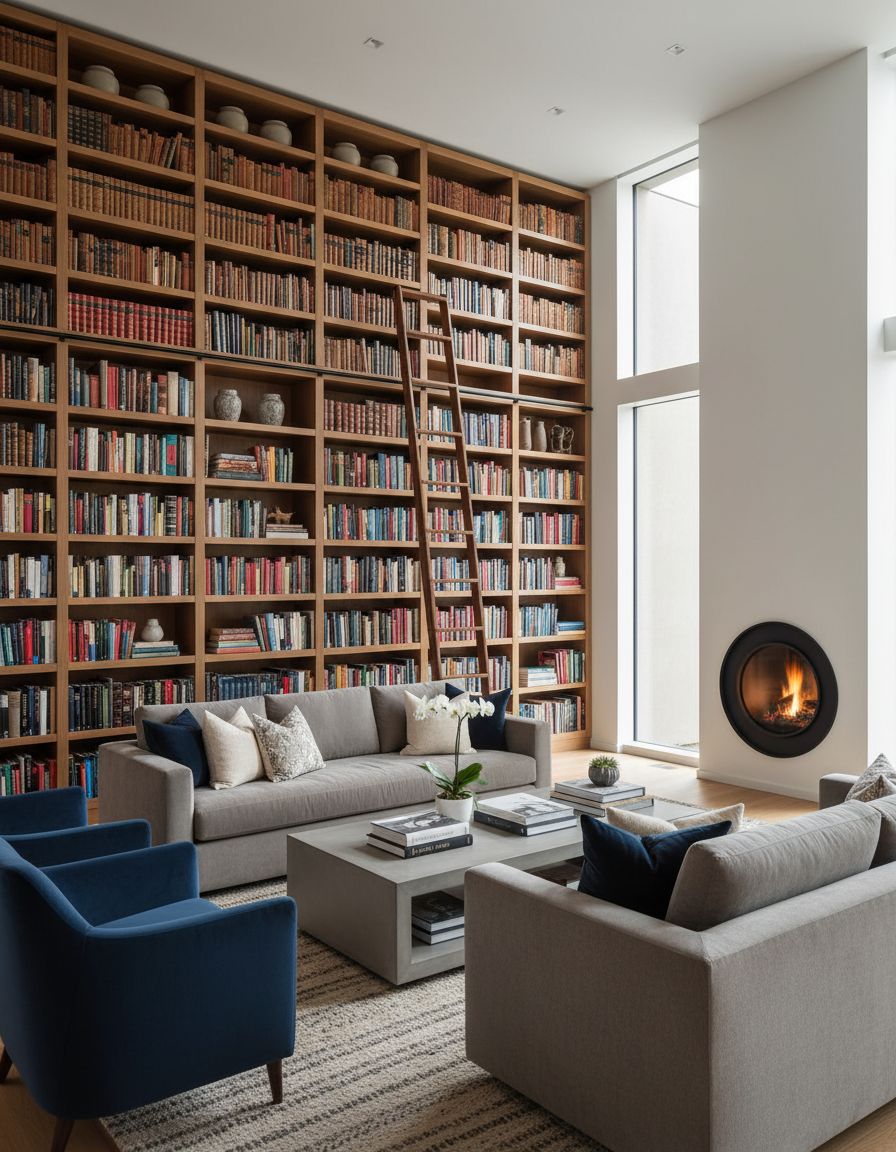
Floor-to-ceiling bookshelves command attention while maximizing vertical real estate, creating what I call “cathedral reading spaces.” This architectural approach transforms entire walls into literary tapestries, establishing an impressive backdrop that doubles as insulation and soundproofing. The psychological impact mirrors standing before something greater than ourselves—intellectually humbling yet deeply comforting, especially when paired with rolling ladders for accessibility.
Cozy Reading Nook Living Room Corner
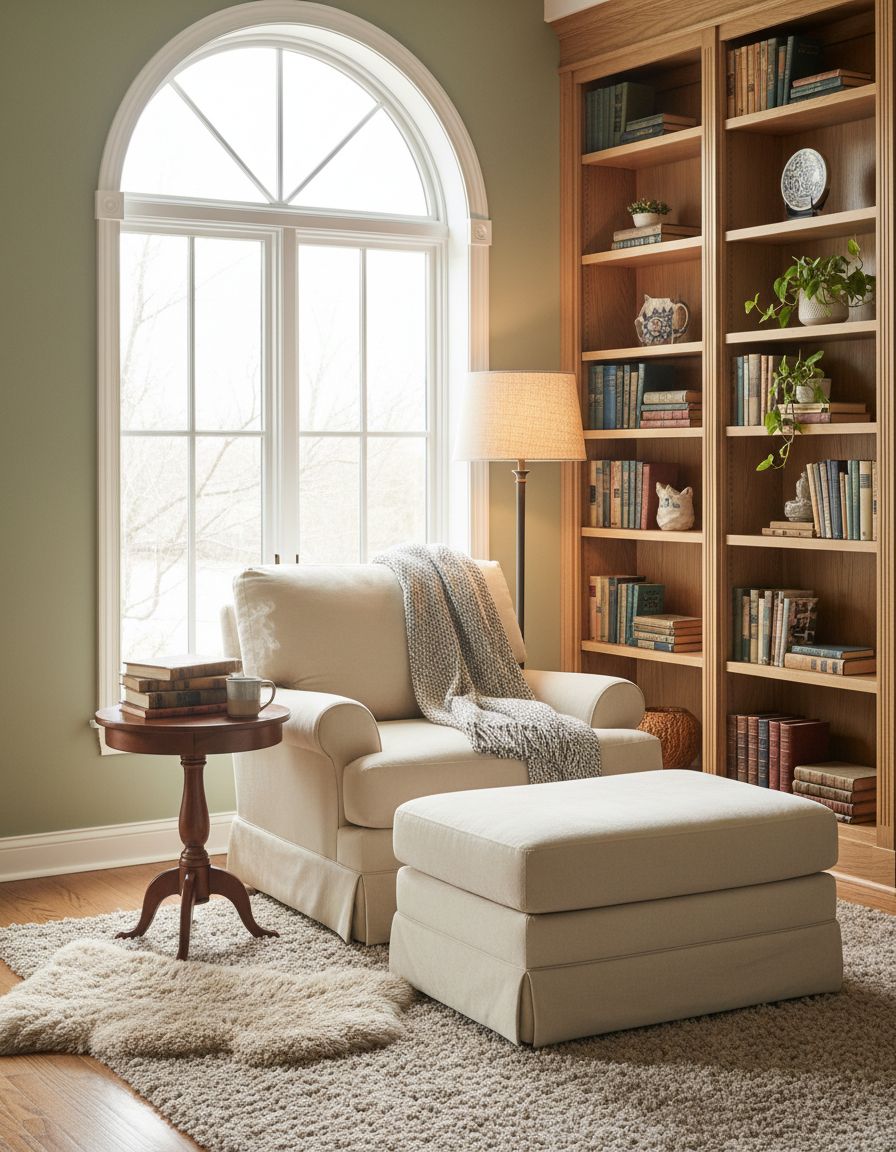
Tucked corners with plush seating and dedicated book storage epitomize what I term “nesting literacy”—spaces designed for psychological retreat. These intimate zones satisfy our primal need for enclosed, protected spaces while indulging in escapist reading. Strategic lighting, throw blankets, and nearby shelving create micro-environments where the outside world dissolves, enabling readers to fully immerse themselves in narrative worlds.
Living Room with Built-In Book Storage
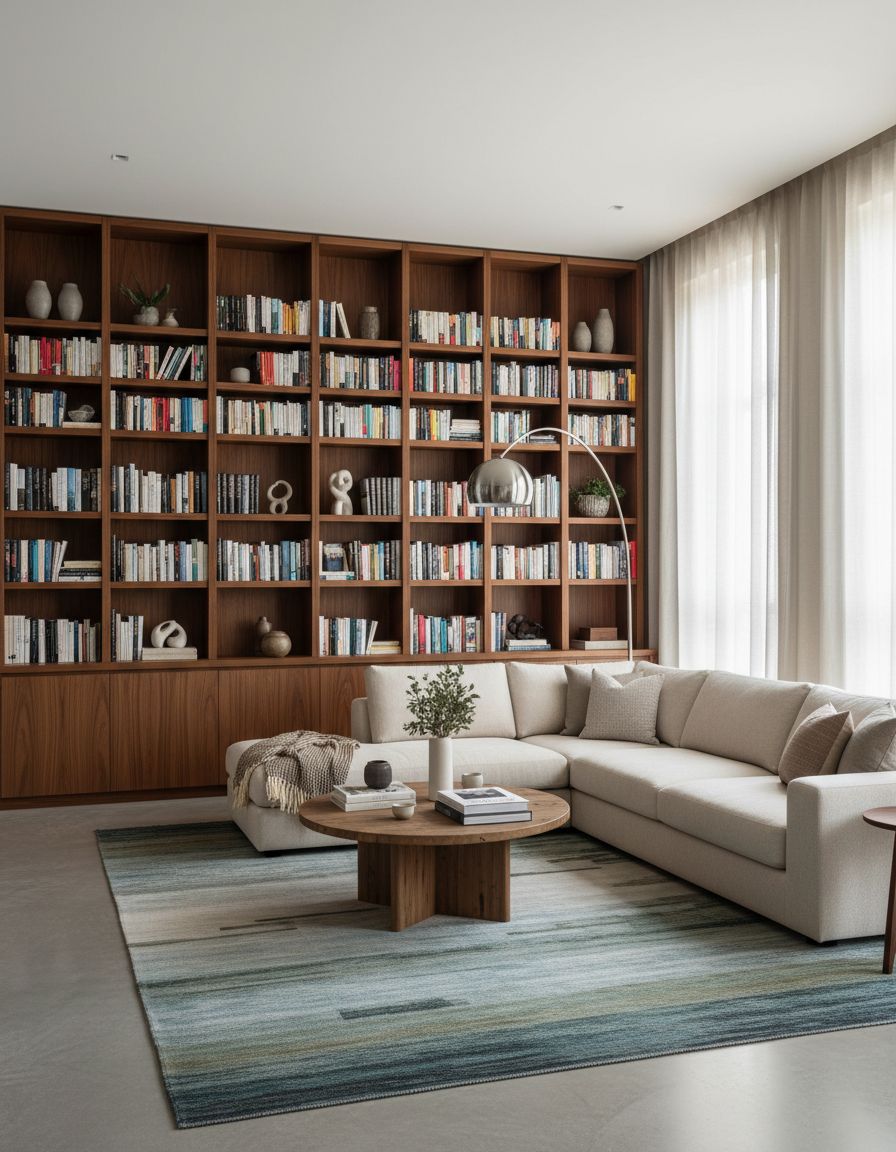
Custom built-ins represent the marriage of architecture and literature, creating seamless integration that appears original to the home’s bones. This permanence communicates commitment to the reading lifestyle, elevating books from decorative afterthought to foundational design element. Built-ins also solve the common problem of mismatched furniture while adding substantial property value through their craftsmanship and functionality.
Library-Style Living Room with Ladder
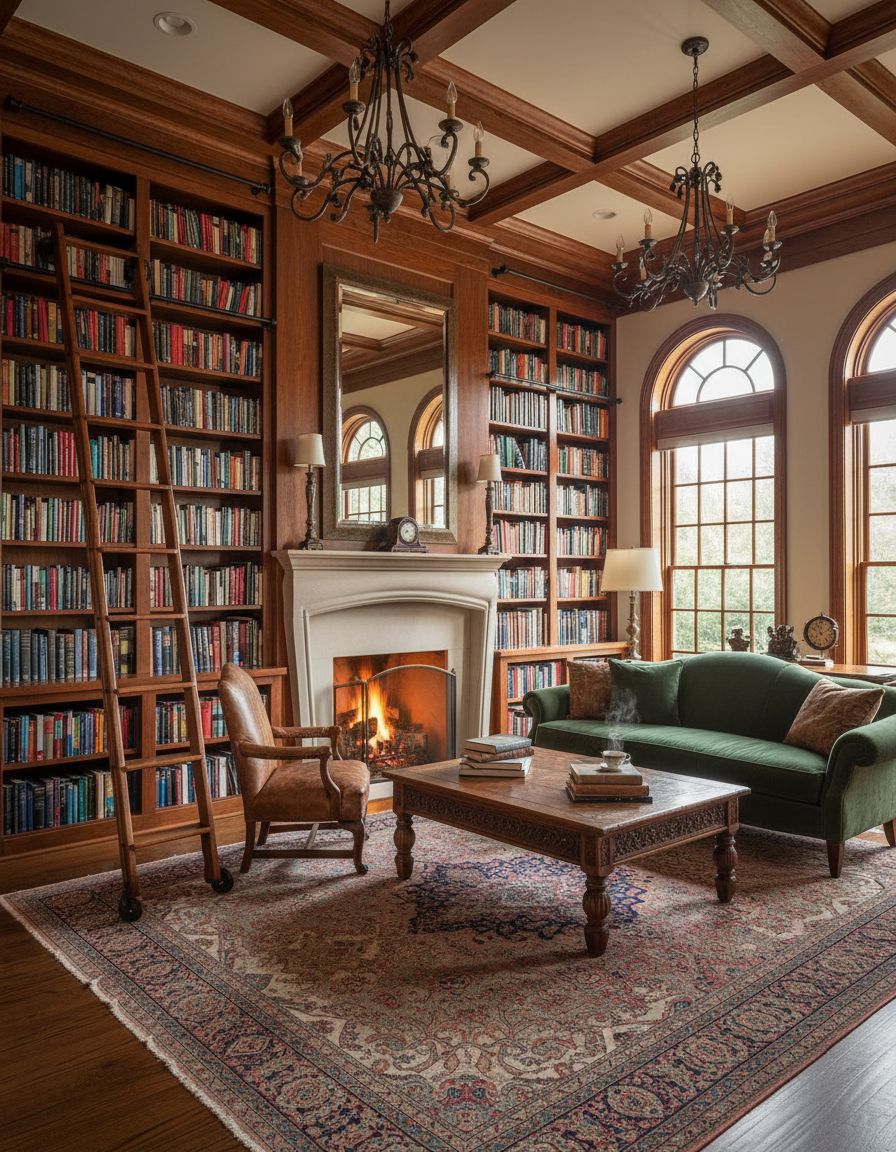
Rolling library ladders inject theatrical elegance while solving practical access challenges in tall-shelf configurations. This design choice channels historic reading rooms, establishing what I call “scholarly grandeur” that transforms everyday living into something ceremonial. The ladder becomes sculptural when stationary, functional when needed, and perpetually romantic—a physical connection to centuries of library tradition.
Living Room Featuring Window Seat Bookshelf
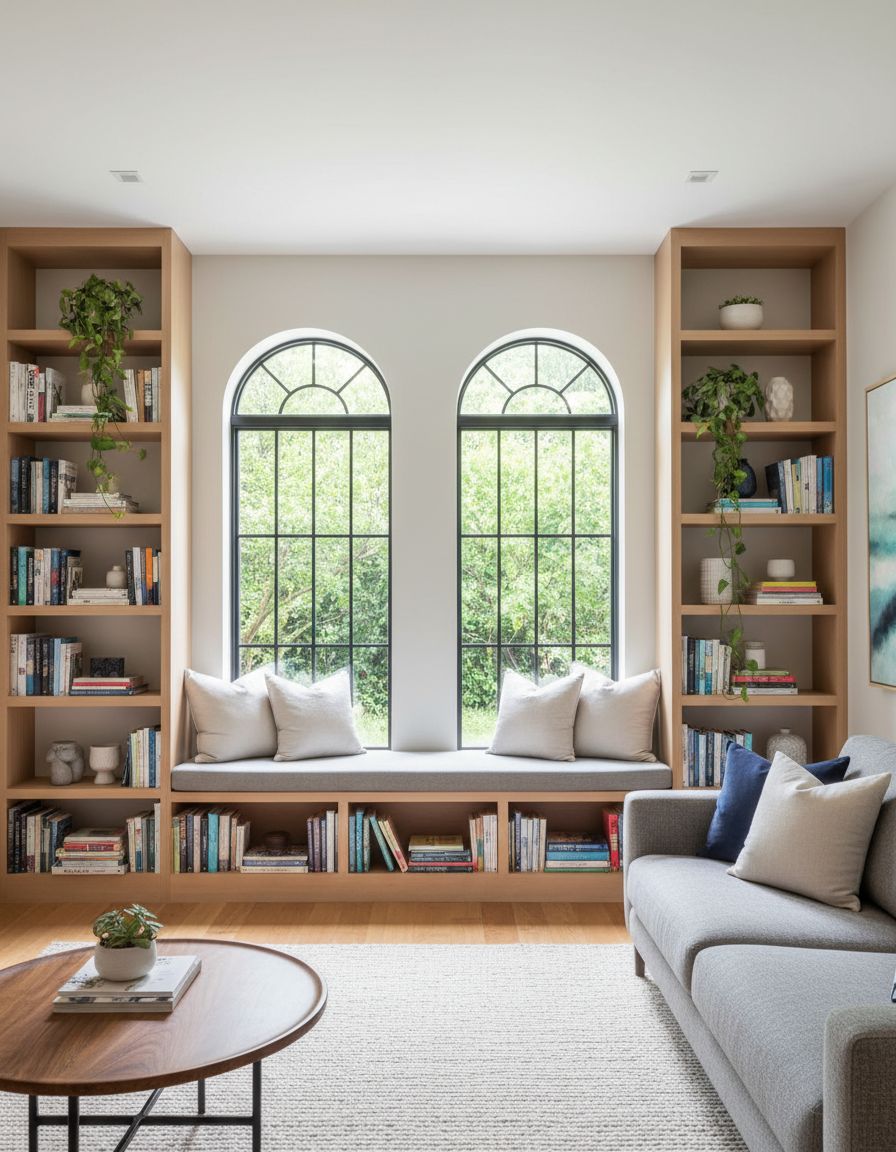
Window seats flanked by bookshelves create irresistible reading destinations by combining natural light with literary access. This configuration taps into our evolutionary preference for protected spaces with environmental awareness—back secure, view outward. The duality of observing external world while diving into internal narratives creates psychological balance, making these spots instinctively magnetic to readers.
Minimalist Living Room with Book Display
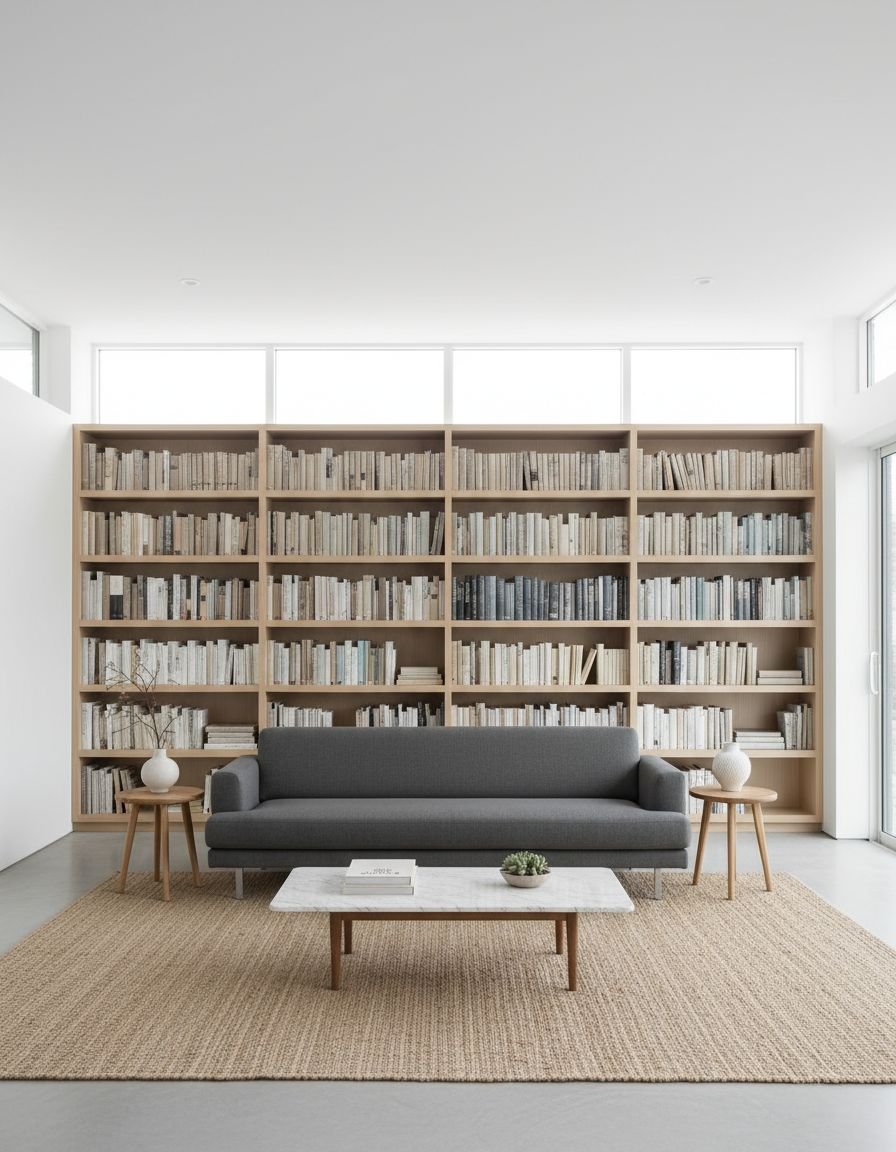
Curated book displays in minimalist settings demonstrate that bibliophilia needn’t mean clutter. Select volumes become artistic installations, their spines and covers contributing color, texture, and intellectual gravitas. This approach, which I call “intentional literary minimalism,” proves that fewer books, thoughtfully presented, can make stronger design statements than overwhelming collections, satisfying both aesthetic and intellectual aspirations.
Living Room with Fireplace Book Walls

Flanking fireplaces with bookshelves creates symmetrical warmth—literal and metaphorical—establishing the hearth as both physical and intellectual center. This configuration recalls historic parlors where families gathered for warmth and storytelling. The juxtaposition of fire’s primal comfort with literature’s civilizing influence creates spaces of profound contentment, activating our deepest associations with safety and enlightenment.
Double-Height Living Room Book Collection
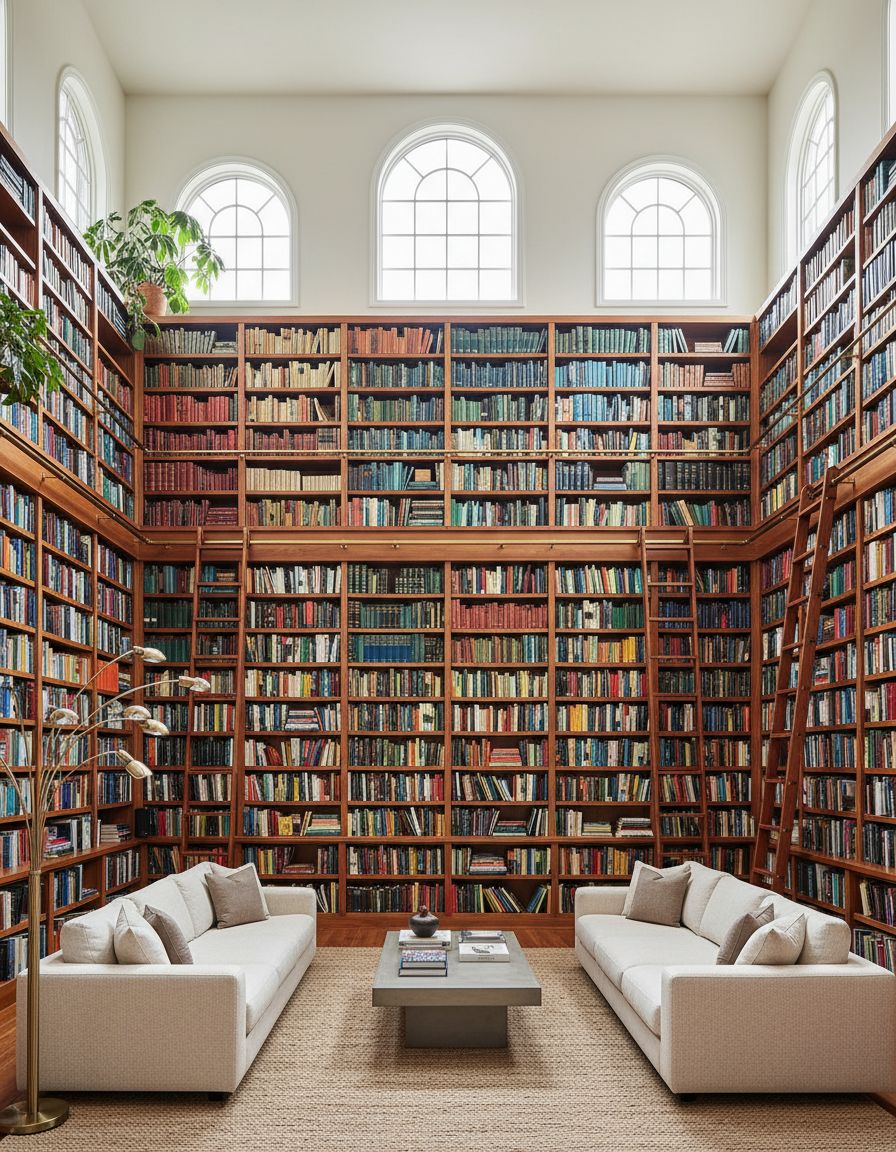
Soaring double-height spaces filled with books create breathtaking vertical drama while showcasing substantial collections. These rooms communicate abundance and aspiration, their scale suggesting limitless intellectual possibility. The architectural grandeur prevents book collections from feeling heavy or oppressive, instead creating airy library atmospheres where literature floats upward, symbolizing knowledge’s transcendent nature and inspiring perpetual curiosity.
Living Room with Hidden Book Storage

Concealed book storage—behind panels, within ottomans, or inside custom furniture—satisfies readers who prefer clean aesthetics without sacrificing collection accessibility. This approach represents “stealth literacy,” honoring books while maintaining visual calm. Hidden storage also protects volumes from sunlight damage and dust while creating delightful discovery moments, as guests encounter unexpected literary caches throughout the space.
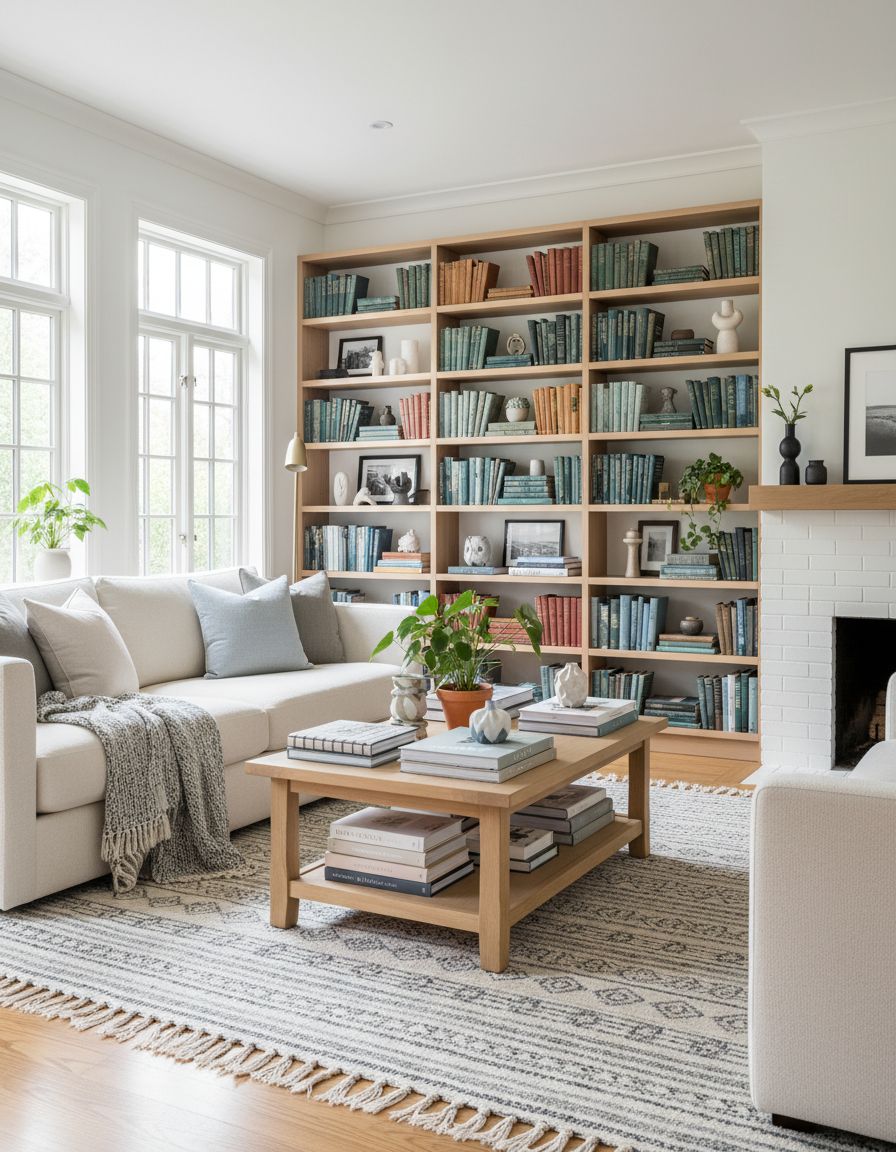
Nordic design principles transform book displays into exercises in restraint and functionality, emphasizing natural materials, white space, and purposeful arrangement. Books integrate as texture and warmth against pale palettes, their presence organic rather than ostentatious. This aesthetic demonstrates that book-loving spaces needn’t feel heavy or academic—they can embody lightness, breathing room, and hygge-inspired coziness.
Living Room Featuring Rotating Book Tower
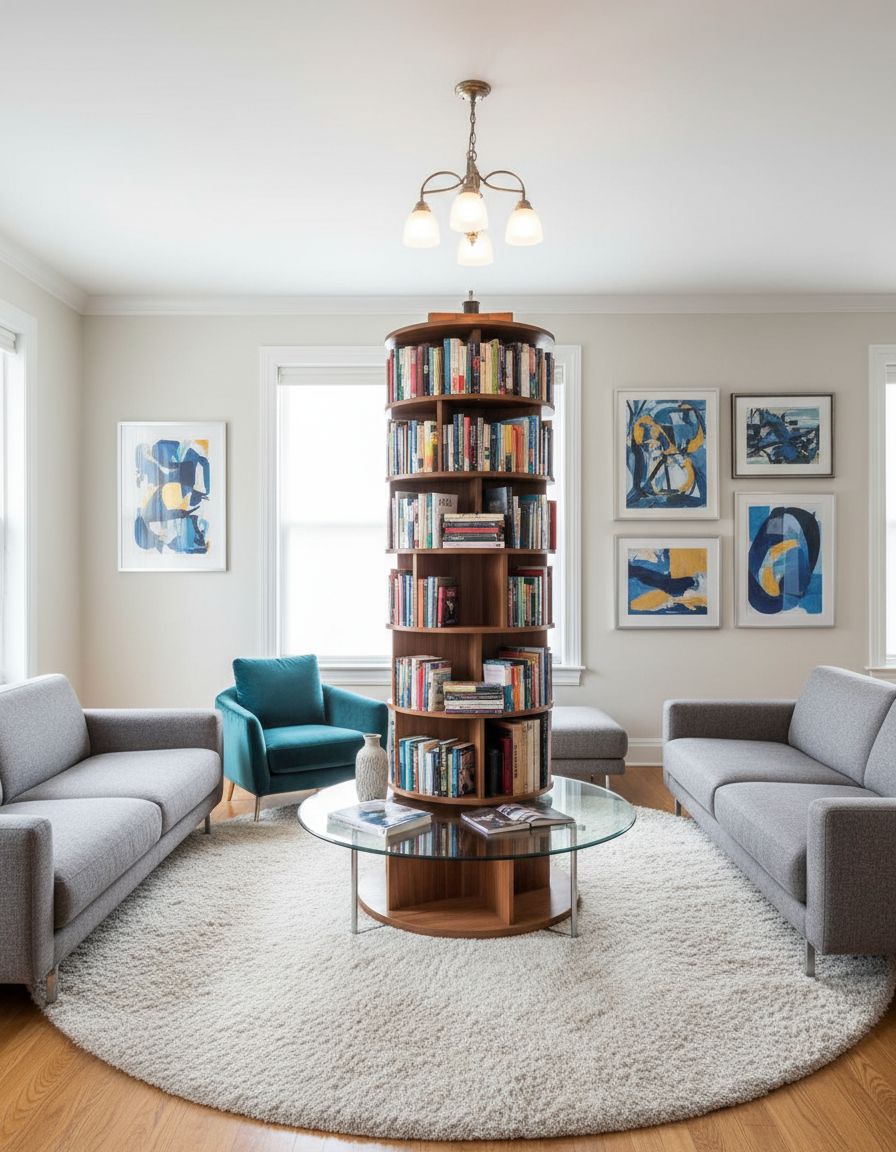
Rotating book towers maximize storage within minimal footprints while adding kinetic sculptural interest. These space-efficient solutions suit urban dwellers with vertical constraints, turning books into interactive installations. The rotation mechanism transforms book selection into tactile engagement, making the physical act of choosing reading material more deliberate and ceremonial—a small ritual that honors the reading experience.
Industrial Living Room with Exposed Book Shelving

Raw materials—steel pipes, reclaimed wood, exposed brick—create edgy backdrops for literary collections, establishing what I term “intellectual grit.” This aesthetic suggests books as tools for mental construction, their presence working alongside industrial elements rather than contradicting them. The juxtaposition of rough textures with refined content creates compelling tension, appealing to readers who reject traditional library stuffiness.
Living Room with Arched Book Alcoves
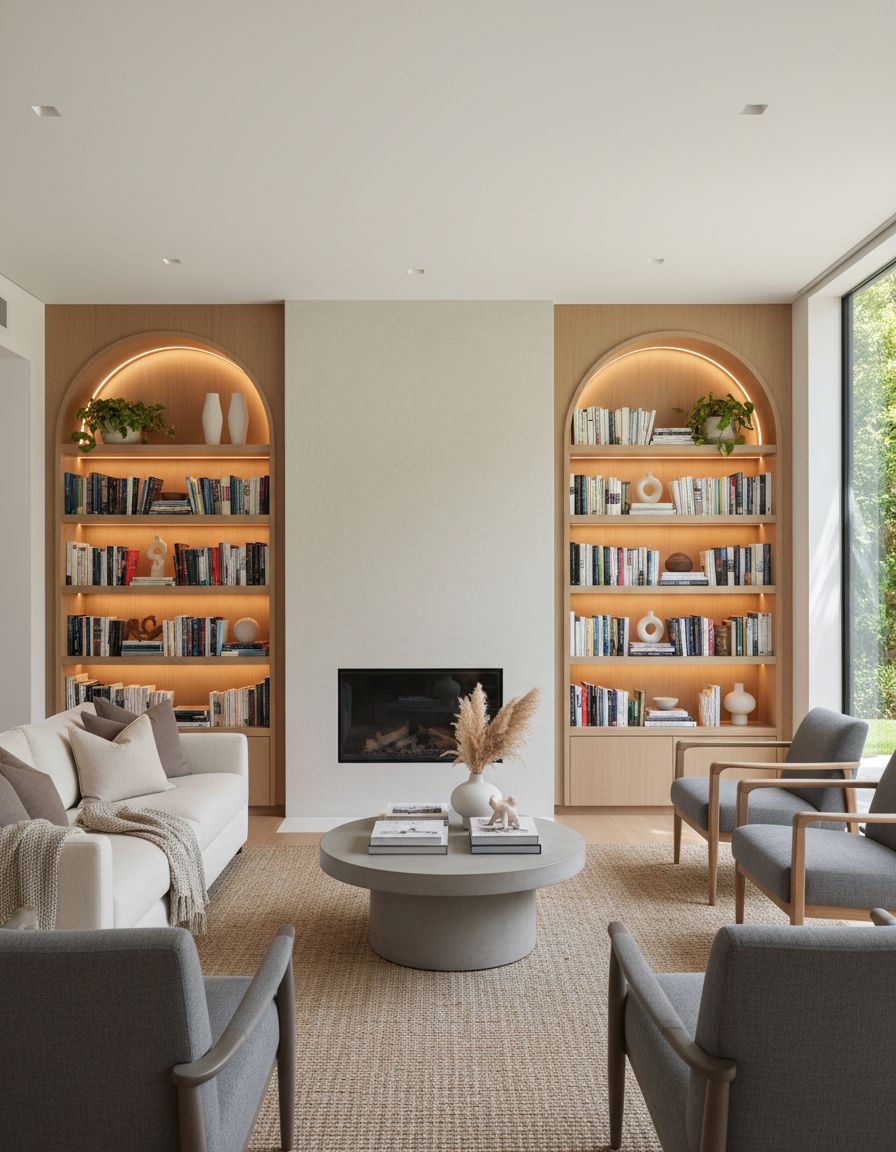
Architectural arches framing book collections add Old World romance and structural elegance, creating distinguished focal points. These recessed alcoves provide natural organization zones while their curves soften the rectilinear nature of book spines. The arch shape subconsciously suggests doorways to other worlds—perfectly appropriate for literature’s transportive power—while adding classical sophistication to contemporary spaces.
Mid-Century Modern Living Room Book Display

Low-profile shelving, walnut finishes, and horizontal emphasis characterize mid-century book displays that complement iconic furniture from the era. This approach integrates books without overwhelming the clean lines and optimistic aesthetic defining 1950s-60s design. Books become part of the curated collection alongside ceramics and artwork, reflecting the period’s intellectual curiosity and design-forward thinking.
Living Room Featuring Color-Coded Book Organization
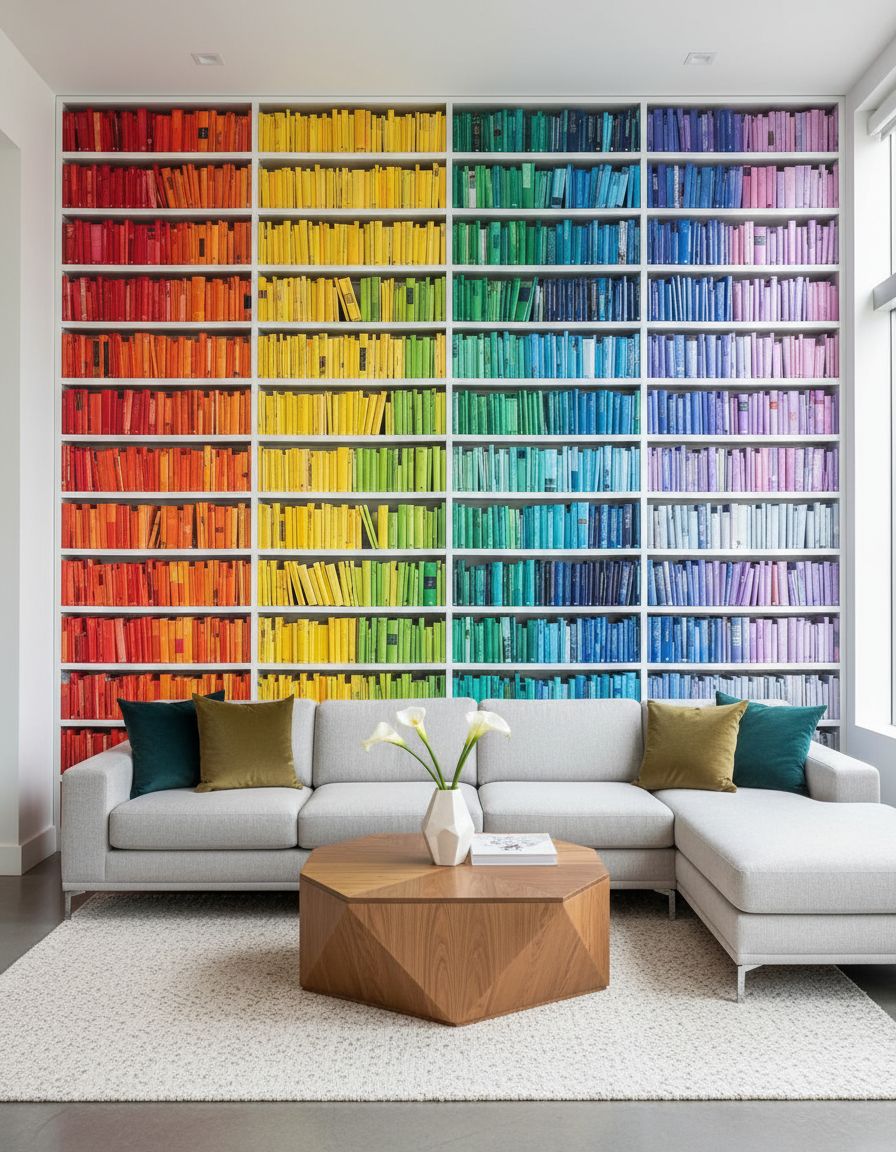
Arranging books by cover color creates striking visual gradients that transform collections into large-scale art installations. While controversial among purists who prefer categorical organization, this method creates undeniable aesthetic impact. Color-coding taps into our neurological response to chromatic harmony, making spaces feel more organized and intentional, even if finding specific titles requires different mental mapping.
Traditional Living Room with Mahogany Bookshelves
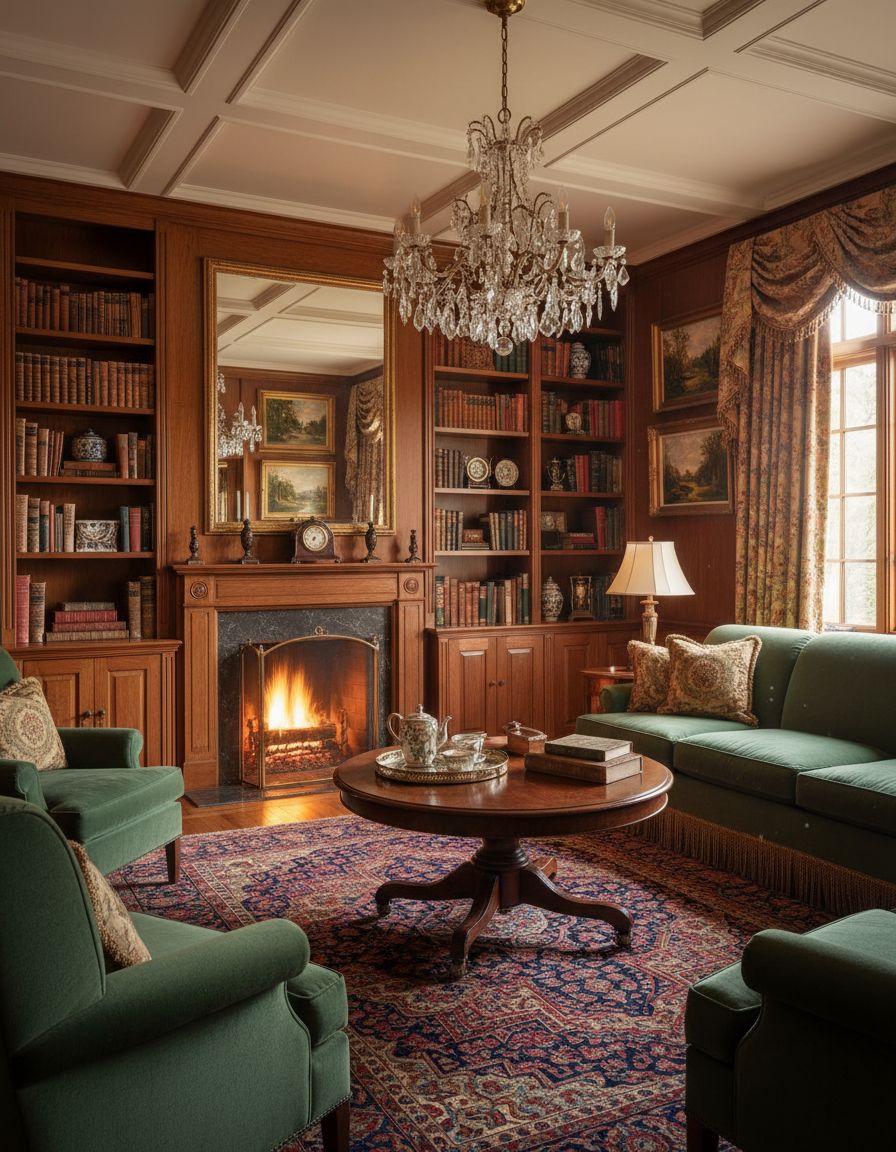
Rich mahogany millwork communicates timeless sophistication, creating living rooms that channel English manor libraries. Dark wood provides gravitas and warmth while honoring centuries of literary tradition. These spaces embrace what I call “inherited intelligence”—the aesthetic suggestion that knowledge passes through generations, accumulating weight and wisdom. The formality encourages thoughtful conversation and contemplative reading rather than casual browsing.
Living Room with Under-Stair Book Nook
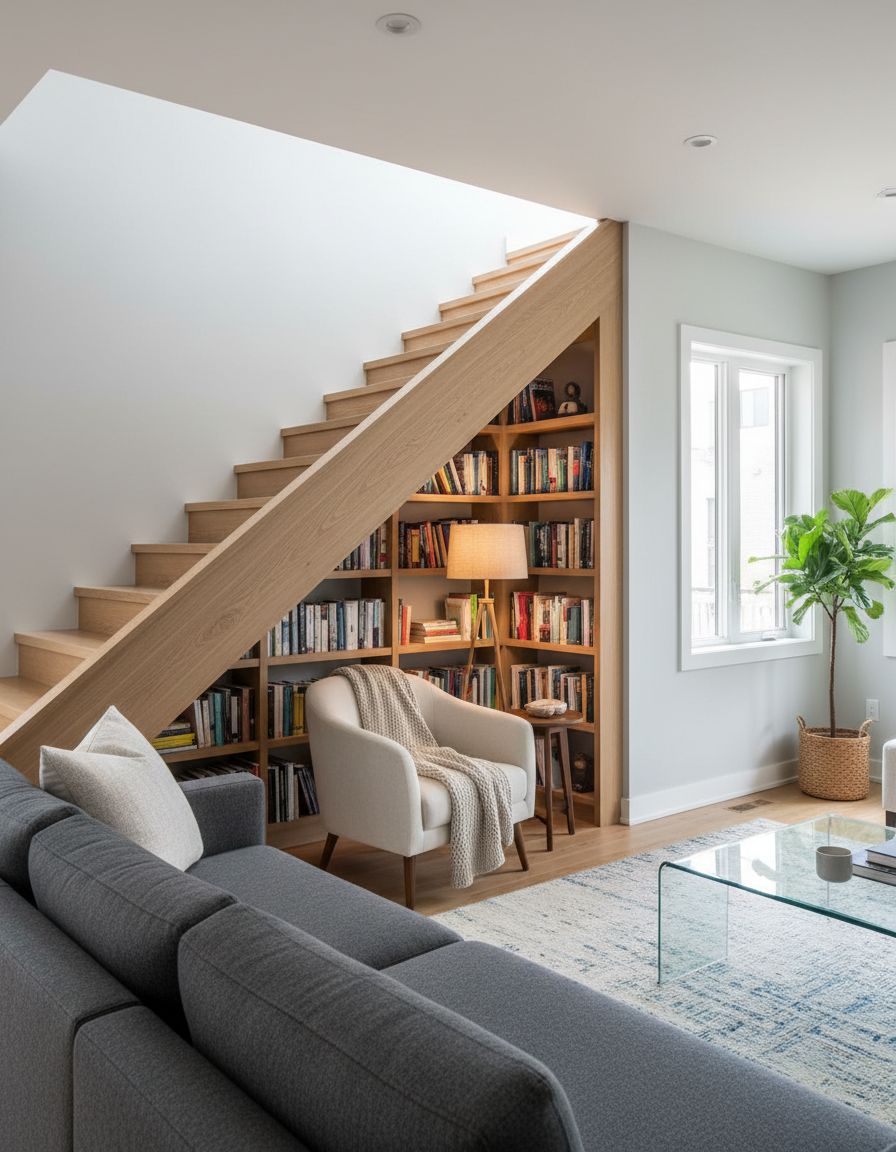
Utilizing under-stair voids for book storage demonstrates spatial ingenuity while creating charming, unexpected literary hideaways. These often-wasted areas become destination reading spots, their compact nature fostering concentration and coziness. The architectural constraint actually enhances appeal—limited space feels protective rather than confining, satisfying our instinct for defendable personal territories dedicated to solitary intellectual pursuits.
Open-Concept Living Room with Book Divider
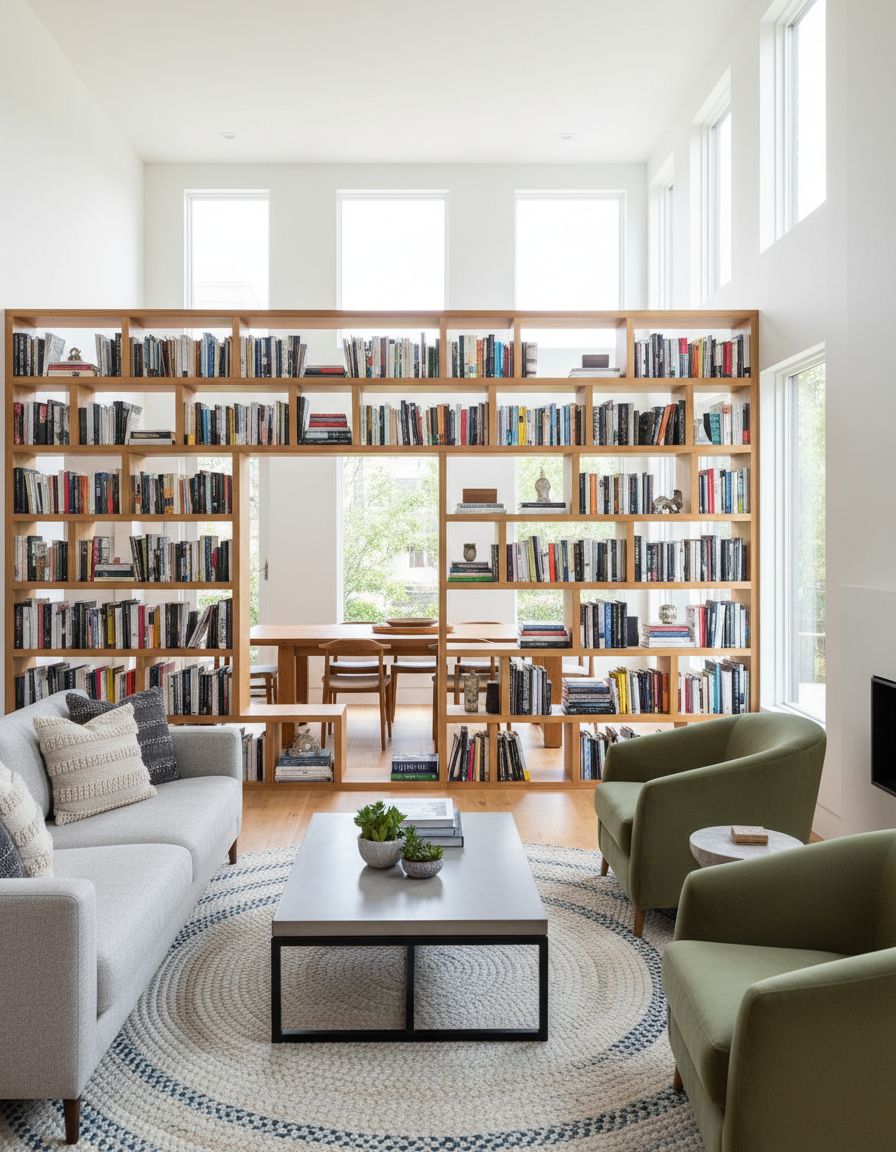
Freestanding bookcases define zones within open floor plans without blocking light or sightlines, creating functional separation that maintains spatial flow. This strategy addresses modern architecture’s challenges while establishing literary presence throughout living areas. Double-sided shelving makes books accessible from multiple vantage points, integrating reading material into daily circulation patterns and encouraging spontaneous literary engagement throughout the day.
Living Room Featuring Floating Book Shelves
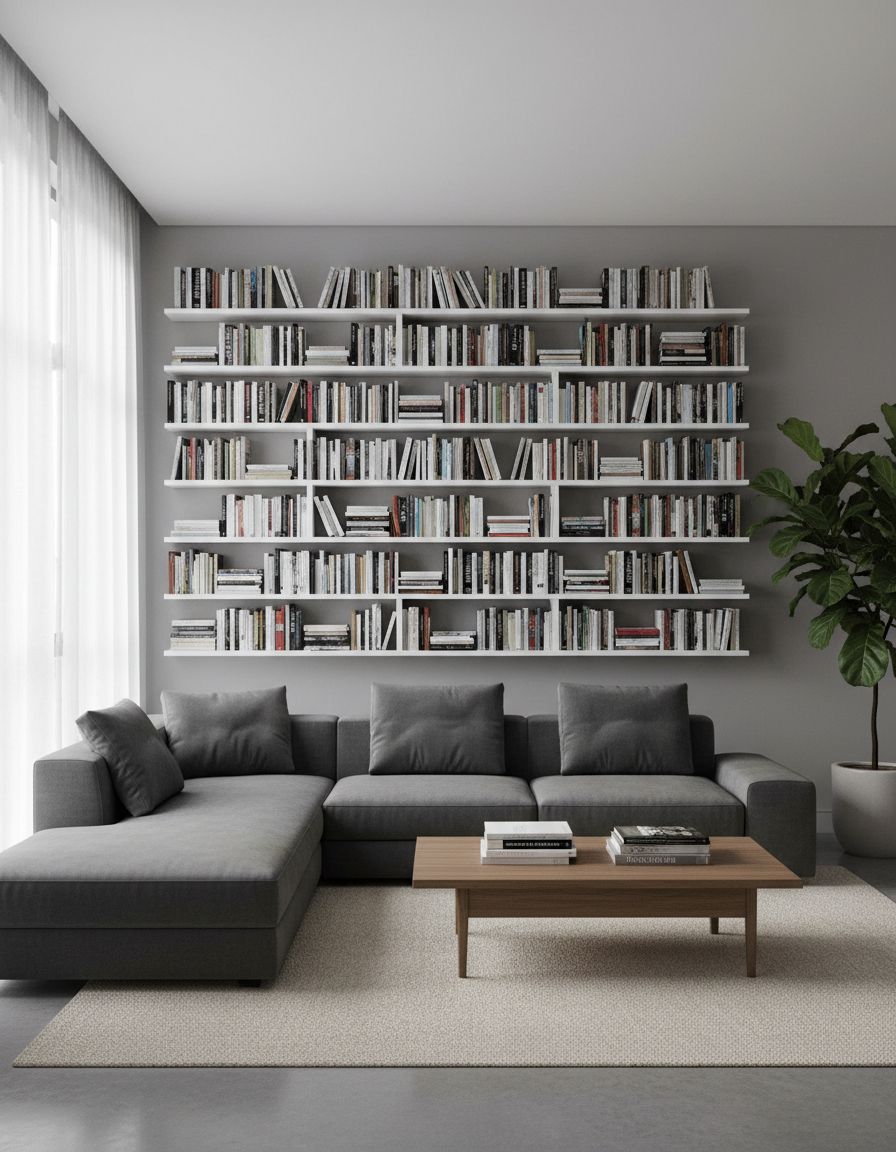
Wall-mounted shelves without visible brackets create magical levitation effects, allowing books to appear suspended in space. This contemporary approach minimizes visual weight while maximizing wall usage, particularly effective in smaller living rooms. Floating shelves suggest literature’s ethereal quality—ideas hovering between concrete reality and abstract thought—while maintaining clean, modern aesthetics that prevent collections from overwhelming rooms.
Cottage-Style Living Room with Book Collections
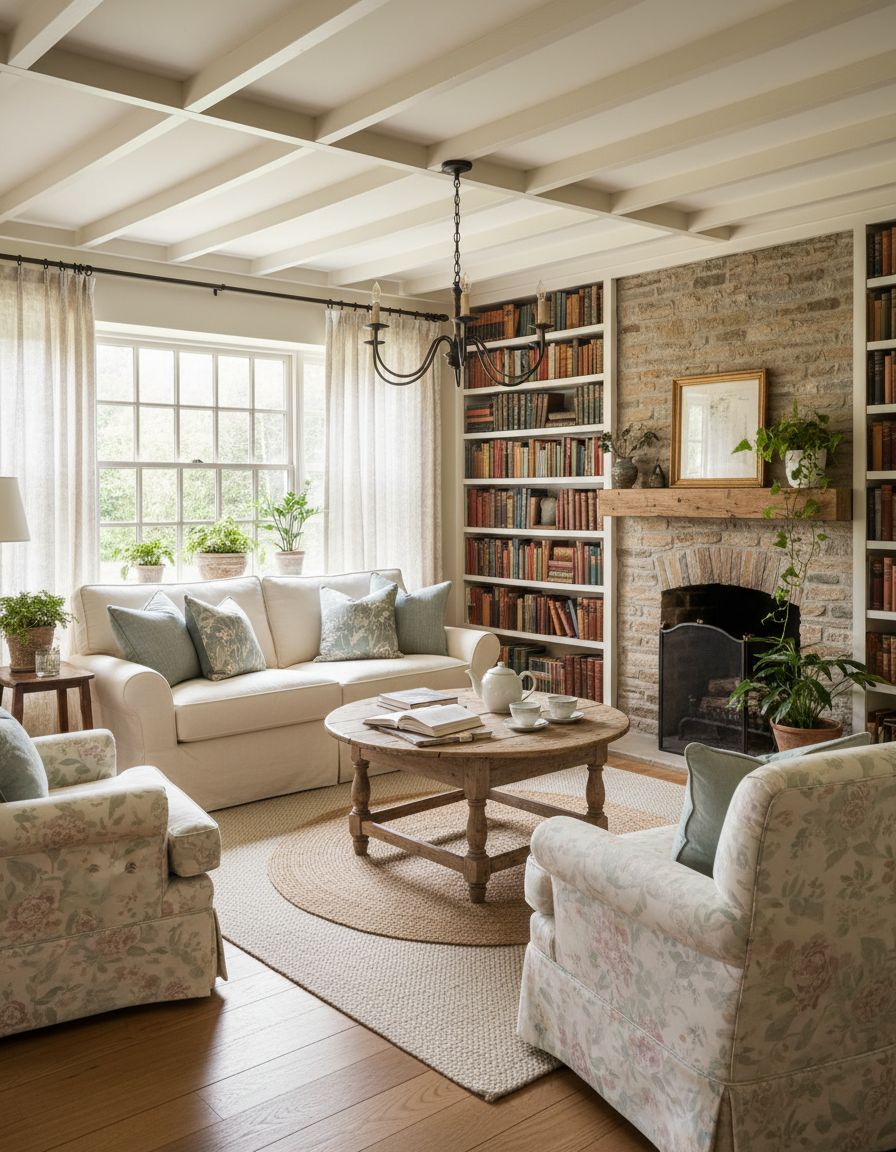
Casual, lived-in arrangements characterize cottage book displays, where volumes stack horizontally, lean casually, and integrate with decorative objects. This relaxed approach communicates that books are companions rather than trophies, meant for reading rather than impressing. The informality creates approachable warmth, suggesting owners who prioritize comfort and authentic engagement with literature over maintaining pristine, intimidating arrangements.
Living Room with Bay Window Book Area

Bay windows naturally accommodate built-in seating surrounded by bookshelves, creating architecturally defined reading destinations. The projection outward provides spatial distinction while flooding areas with natural light—ideal for reading. These configurations maximize otherwise challenging architectural features, turning them into crown jewels where panoramic views meet literary escape, offering readers the best of both observational worlds.
Contemporary Living Room Featuring Book Art
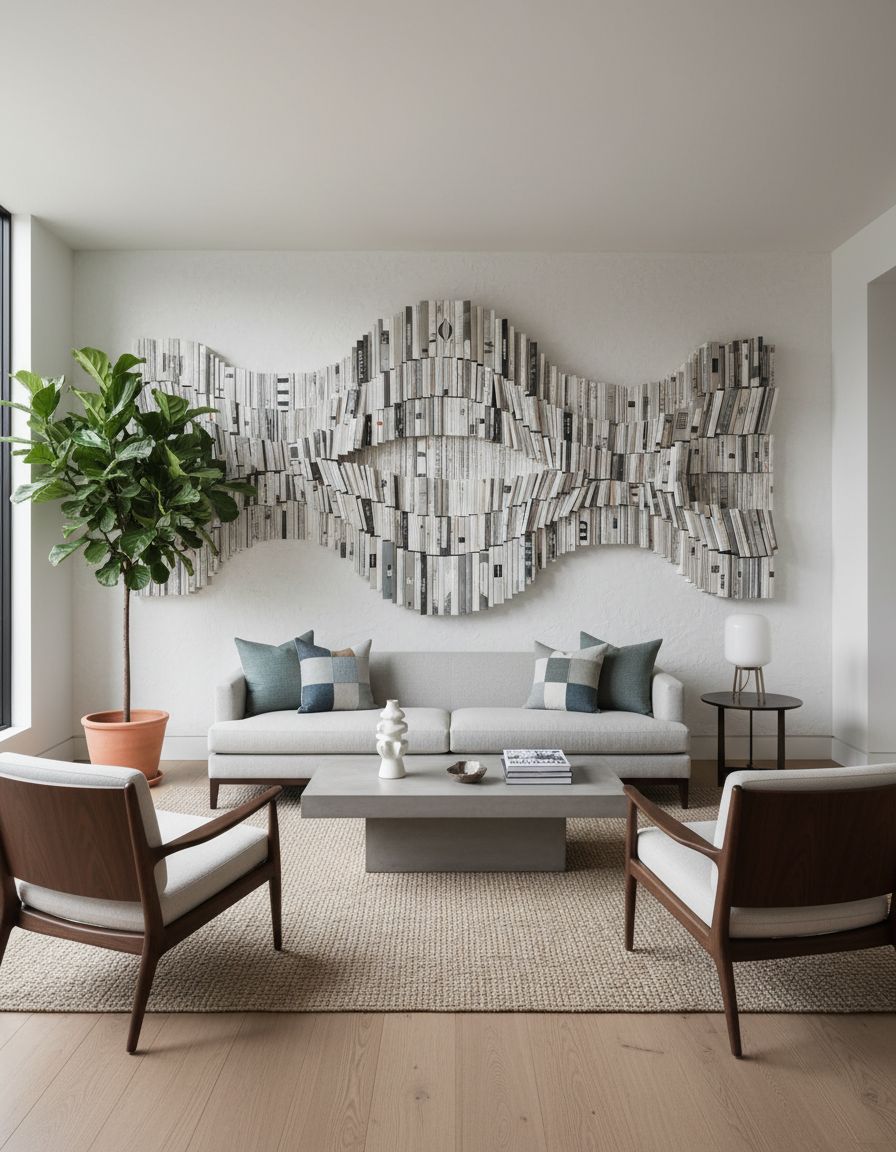
Strategic styling transforms books into artistic installations through creative stacking, sculptural arrangements, and integration with gallery walls. This curatorial approach positions literature as visual art, honoring content while celebrating physical beauty. Book-as-art displays work particularly well with vintage volumes, first editions, or visually striking covers, creating conversation pieces that bridge intellectual and aesthetic appreciation.
Living Room with Backlit Book Displays

Integrated LED lighting behind or within shelving creates dramatic illumination that showcases collections while providing ambient lighting. Backlighting adds depth, making books appear to glow with inner knowledge—literally enlightening the space. This theatrical approach works especially well with glass shelves or strategic gaps, creating layered lighting effects that transform ordinary shelving into architectural features worthy of museums.
Bohemian Living Room with Vintage Books
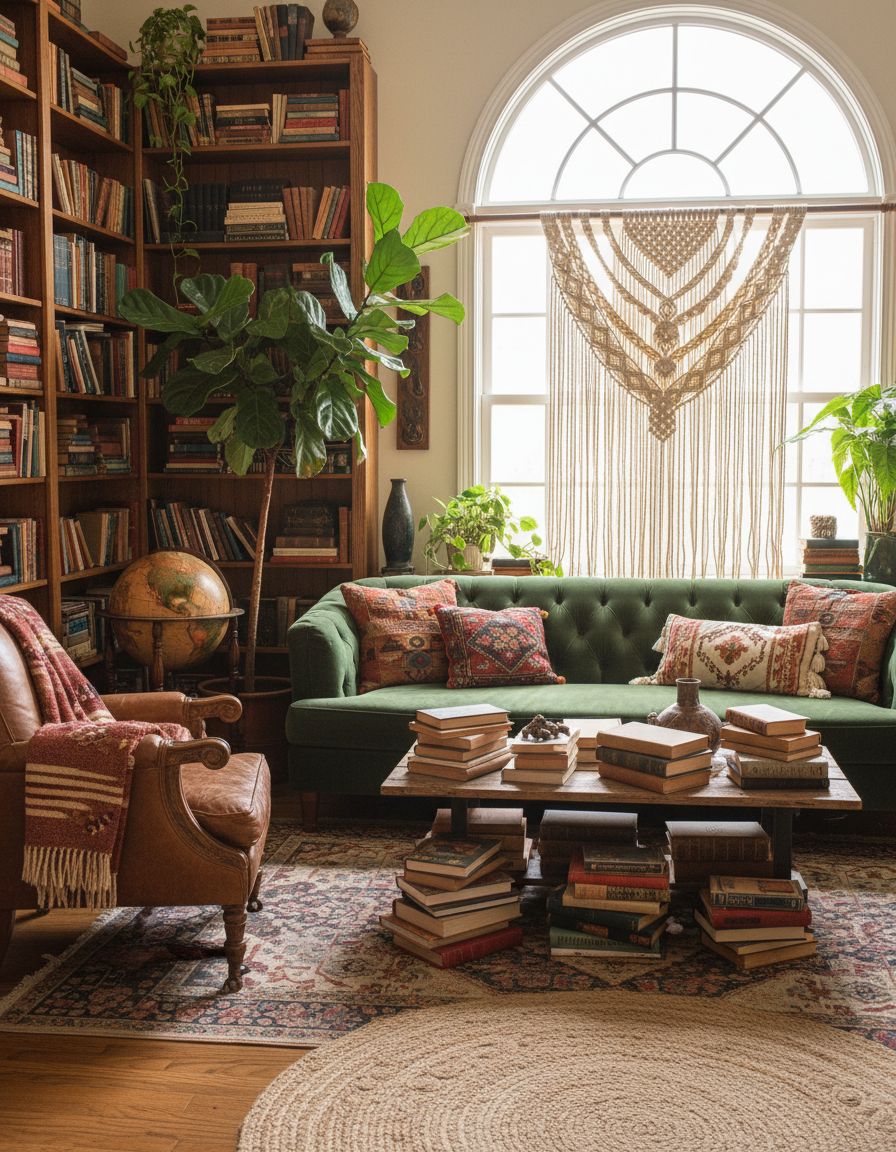
Eclectic arrangements featuring weathered volumes, global textiles, and layered patterns create what I call “wandering scholar” aesthetics. Books integrate organically among collected treasures from travels and thrift stores, suggesting intellectual curiosity that extends beyond Western canon. The relaxed, anti-establishment vibe celebrates knowledge acquisition as adventure rather than academic duty, making literary spaces feel accessible and personally meaningful.
Living Room Featuring Corner Book Tower
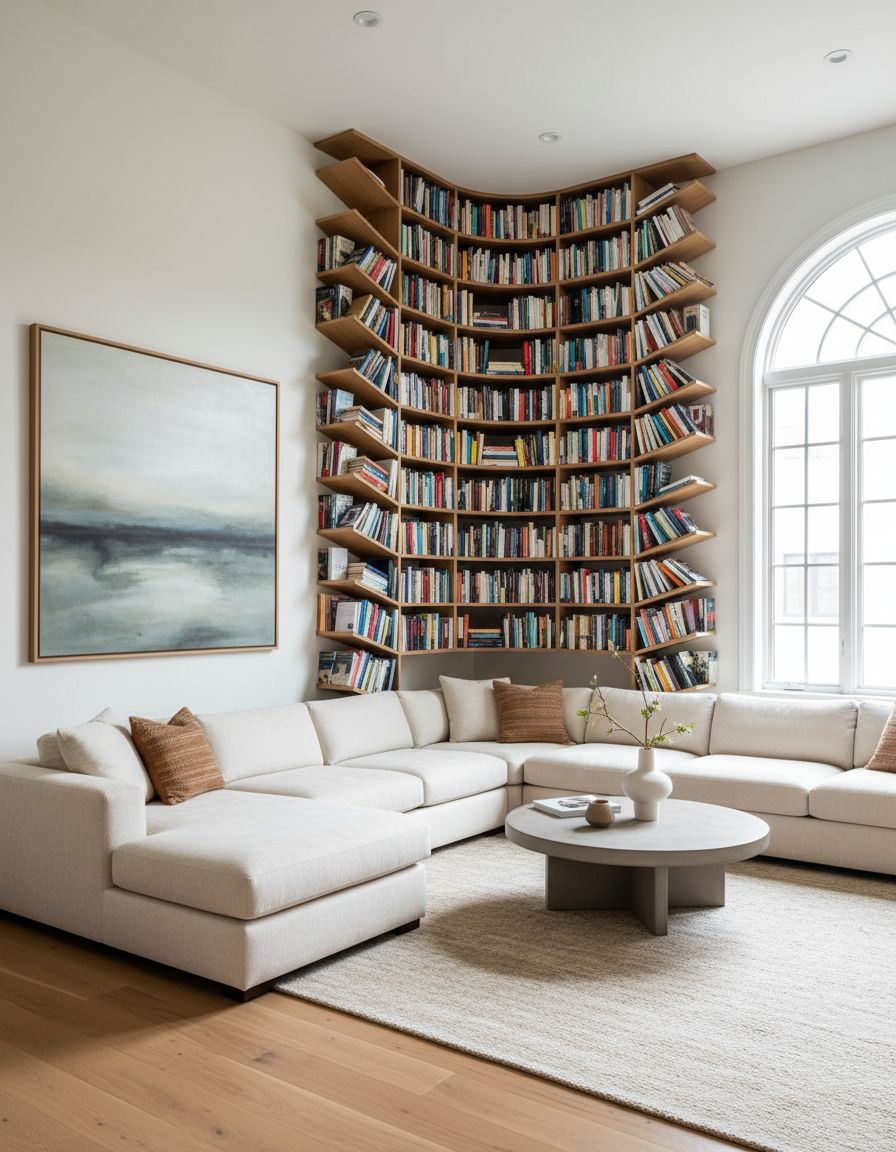
Vertical corner installations maximize often-underutilized angles while creating striking architectural moments. These towers draw eyes upward, making rooms feel taller while providing substantial storage within small footprints. Corner placement also creates natural browsing destinations—physical endpoints that encourage pausing and selecting reading material, turning spatial planning into behavioral design that promotes engagement with collections.
Transitional Living Room with Symmetrical Bookshelves
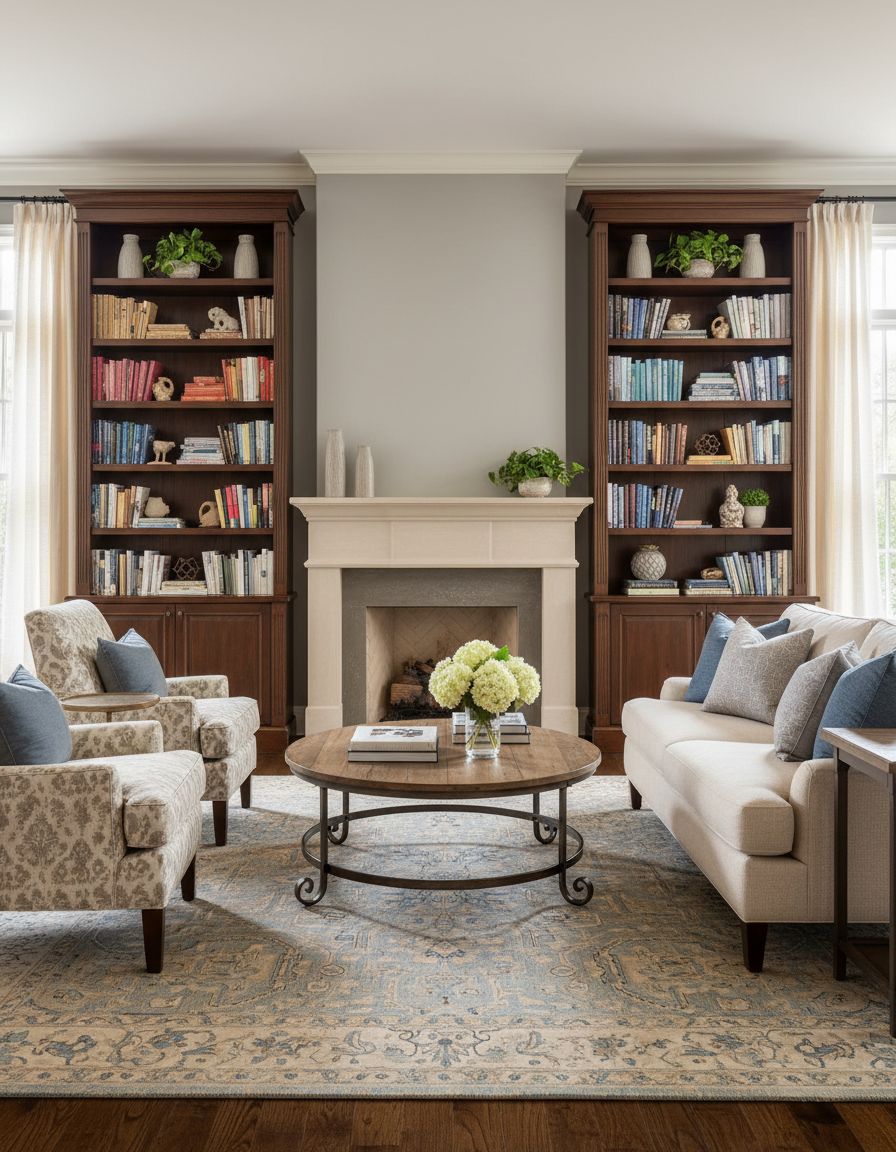
Balanced flanking shelves satisfy our psychological preference for symmetry while creating formal elegance bridging traditional and contemporary aesthetics. This approach anchors focal points—fireplaces, windows, or media centers—with scholarly gravitas. Symmetry communicates order and intentionality, suggesting intellectual discipline while the transitional style prevents spaces from feeling either too stuffy or too casual, achieving timeless sophistication.
Living Room with Recessed Book Niches
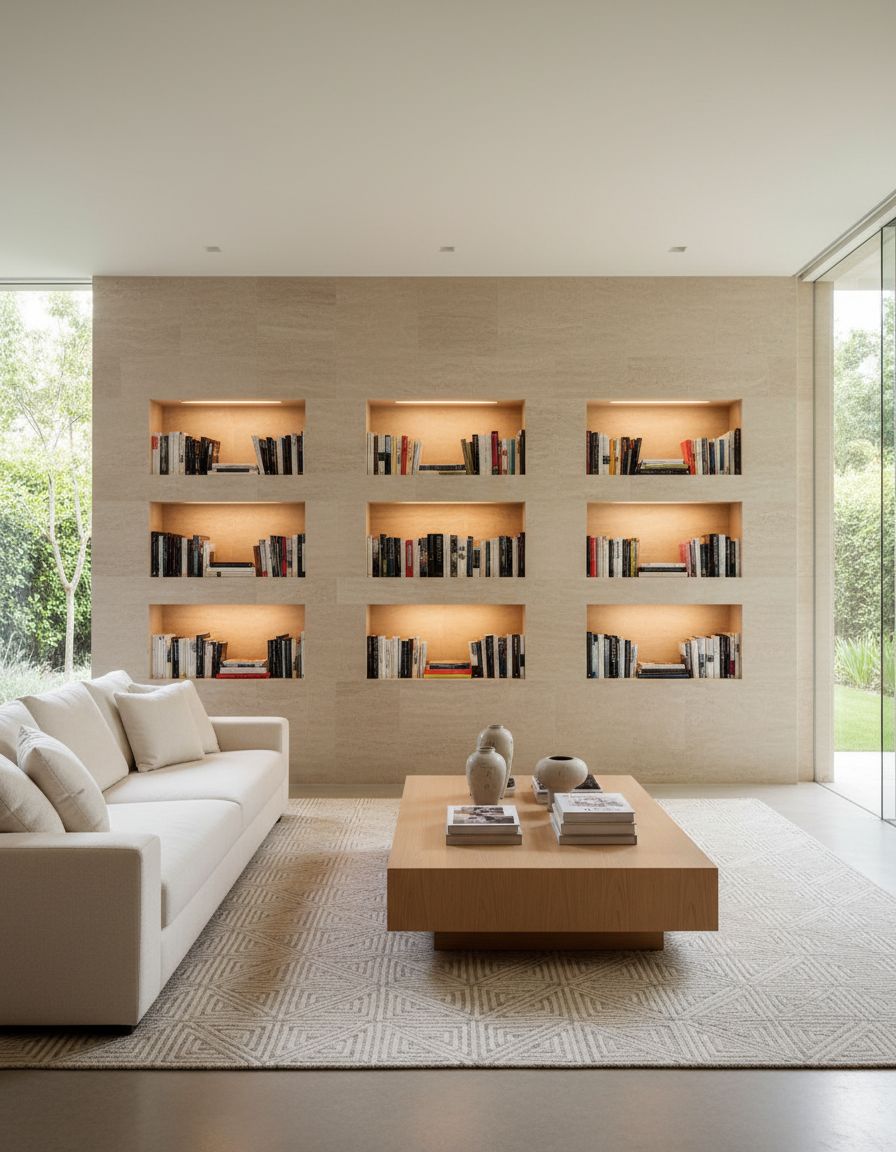
Built-in recessed compartments create dimensional interest while maintaining flush wall planes. These architectural interventions establish permanent book homes that feel original to structural design rather than furniture additions. Recessing prevents shelves from protruding into living space while creating shadow lines that add visual complexity. The permanence signals long-term commitment to literary lifestyle, literally building reading into home foundations.
Coastal Living Room with Casual Bookshelf
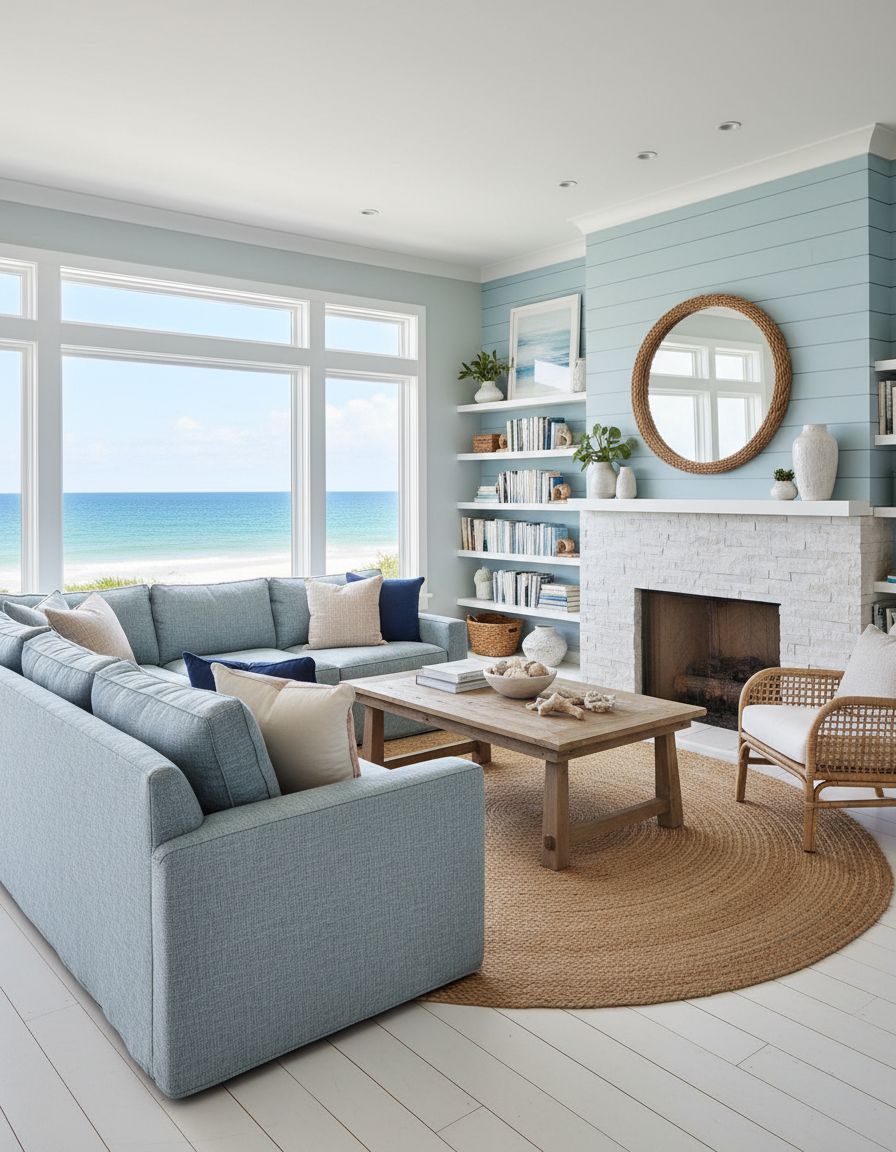
Weathered finishes, light woods, and relaxed arrangements characterize beach-inspired book displays that prioritize ease over formality. Books integrate with nautical elements and natural textures, creating vacation-mode atmospheres conducive to leisure reading. This aesthetic suggests literature as pleasure rather than obligation, perfect for mysteries, beach reads, and escape fiction that complements coastal living’s inherent relaxation and temporal suspension.
Living Room Featuring Modular Book Units

Reconfigurable shelving systems adapt to changing collections and spatial needs, offering flexibility that permanent built-ins cannot. Modular units appeal to renters and frequent movers while providing design evolution opportunities as tastes mature. This adaptability reduces commitment anxiety, making substantial book furniture investments feel less permanent. The contemporary aesthetic typically features clean lines that transition seamlessly between homes and design schemes.
Rustic Living Room with Barn-Wood Bookshelves
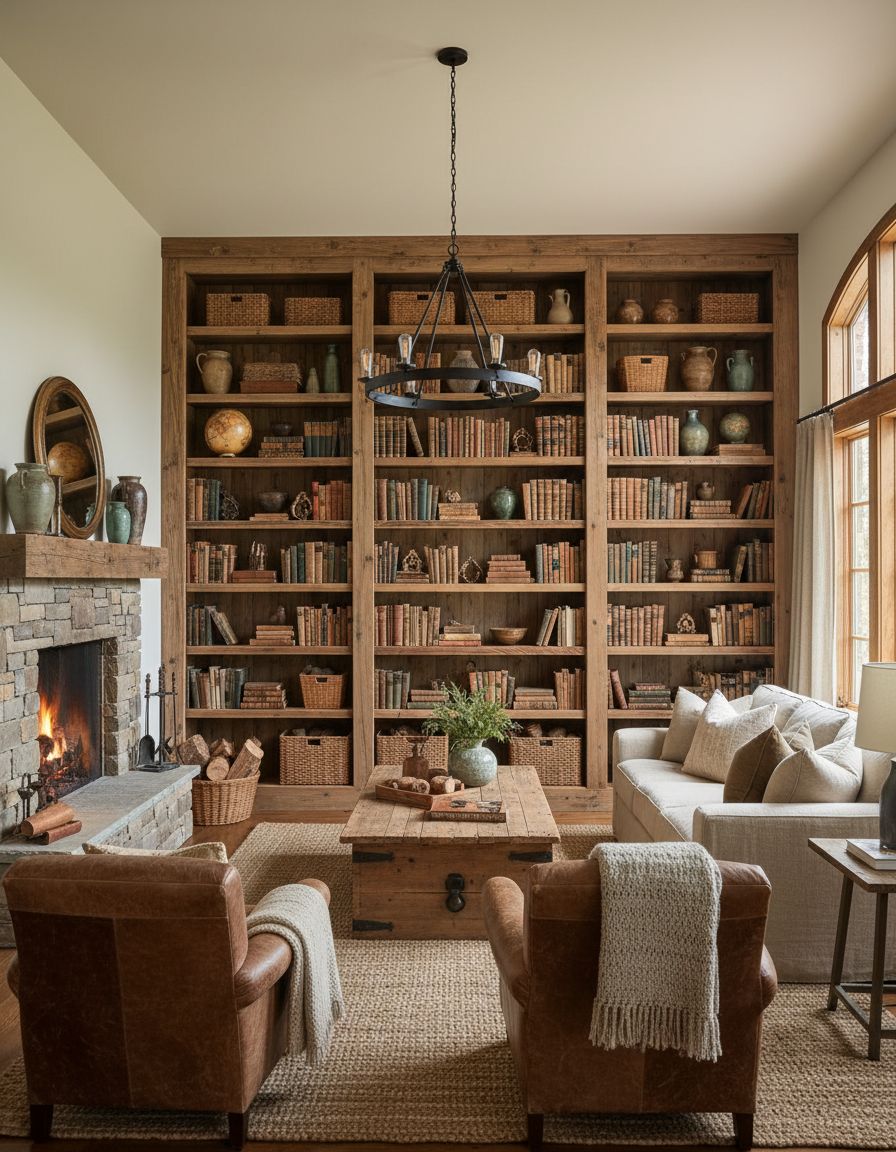
Reclaimed wood shelving brings textural warmth and historical character while supporting sustainable design principles. Each plank’s imperfections tell stories that complement literary narratives housed upon them. This approach creates what I term “narrative layering”—where both container and content carry meaning. The rustic aesthetic suggests unpretentious intelligence, knowledge grounded in lived experience rather than ivory-tower abstraction.
Living Room with Dedicated Book Gallery Wall
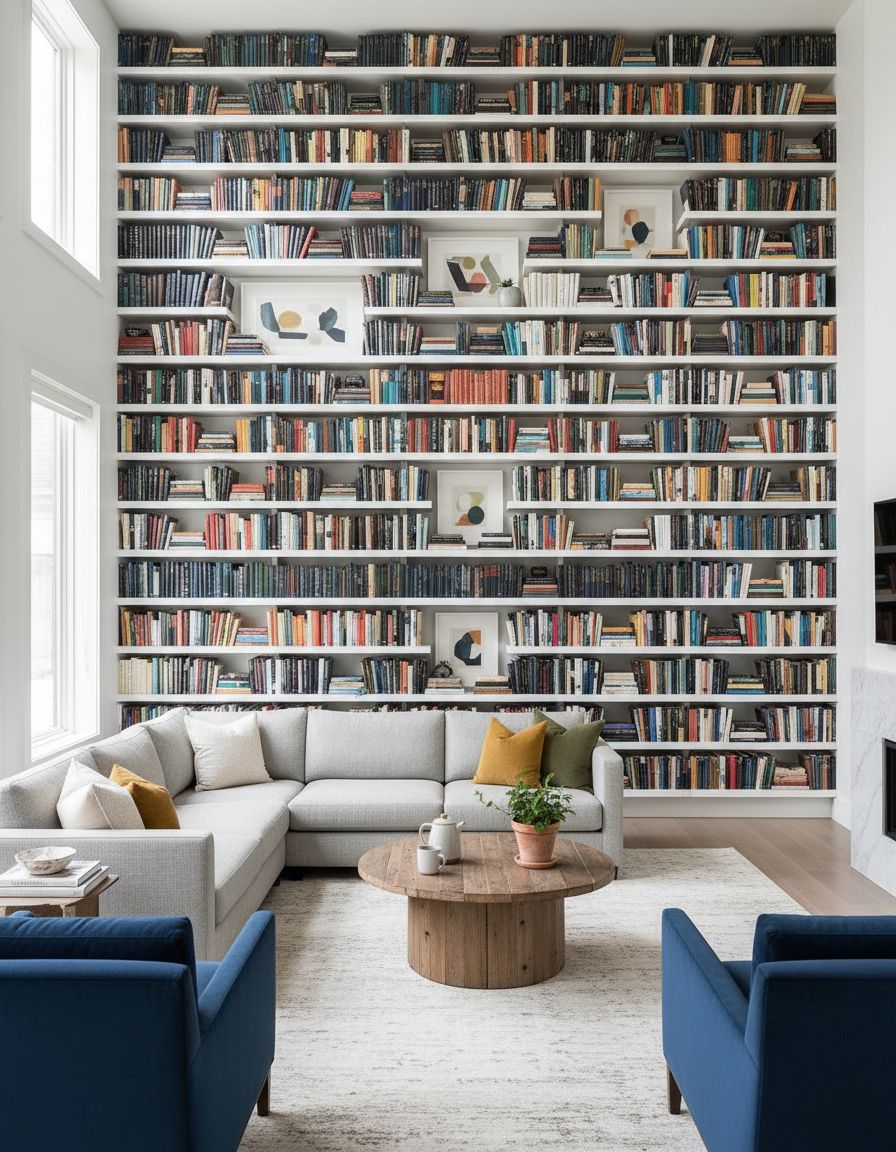
Arranging books as wall installations—sometimes behind glass or in shadow boxes—elevates special editions to museum-worthy displays. This curatorial approach works beautifully for valuable first editions, inherited collections, or visually spectacular volumes deserving protection and prominence. The gallery treatment communicates reverence for physical books as cultural artifacts, not merely content delivery vehicles, honoring craftsmanship alongside intellectual contribution.
Art Deco Living Room with Glamorous Bookcases
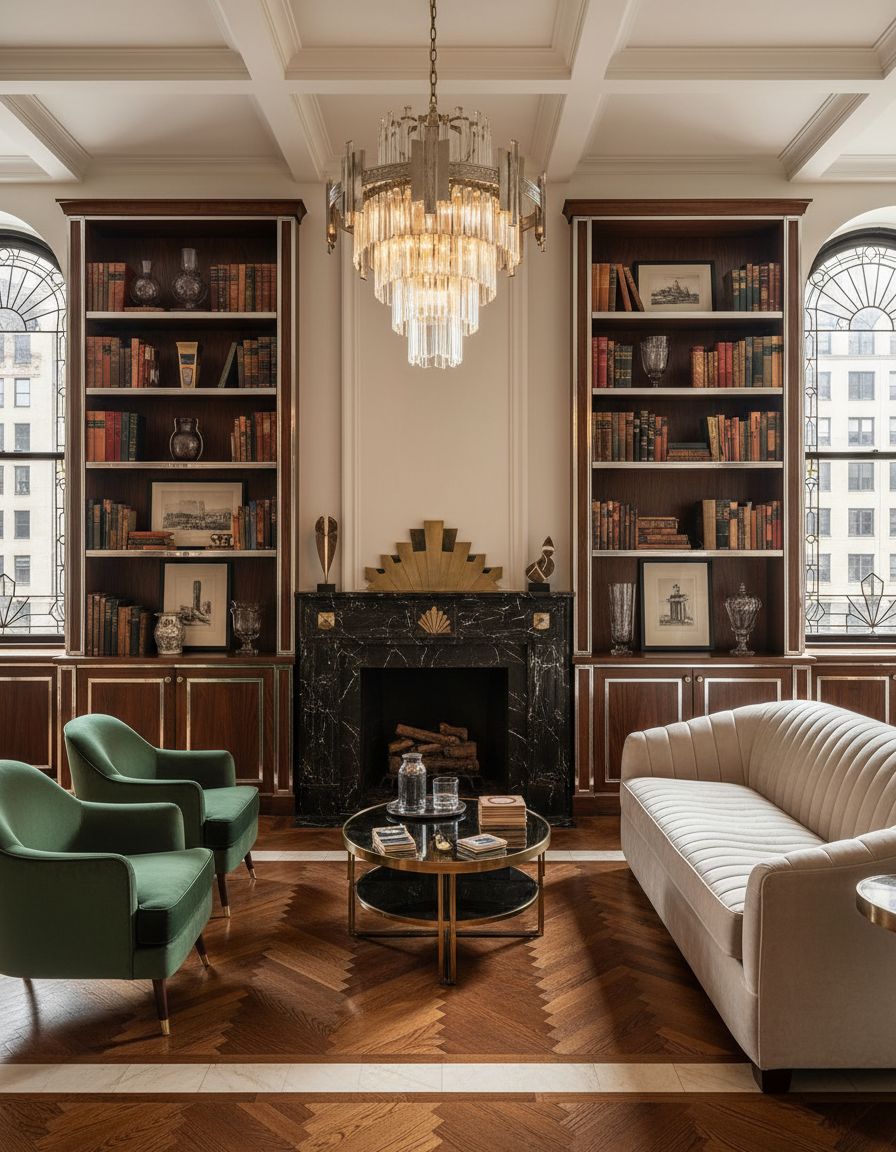
Geometric patterns, luxe materials, and metallic accents characterize Art Deco book displays that celebrate Jazz Age optimism and sophistication. Glass-front cases with brass details protect valuable collections while showcasing them theatrically. This glamorous approach positions reading as cultured leisure activity for the aesthetically refined, creating living rooms that feel like private clubs where literature meets luxury in perfect, glittering harmony.
Living Room Featuring Multi-Purpose Book Furniture
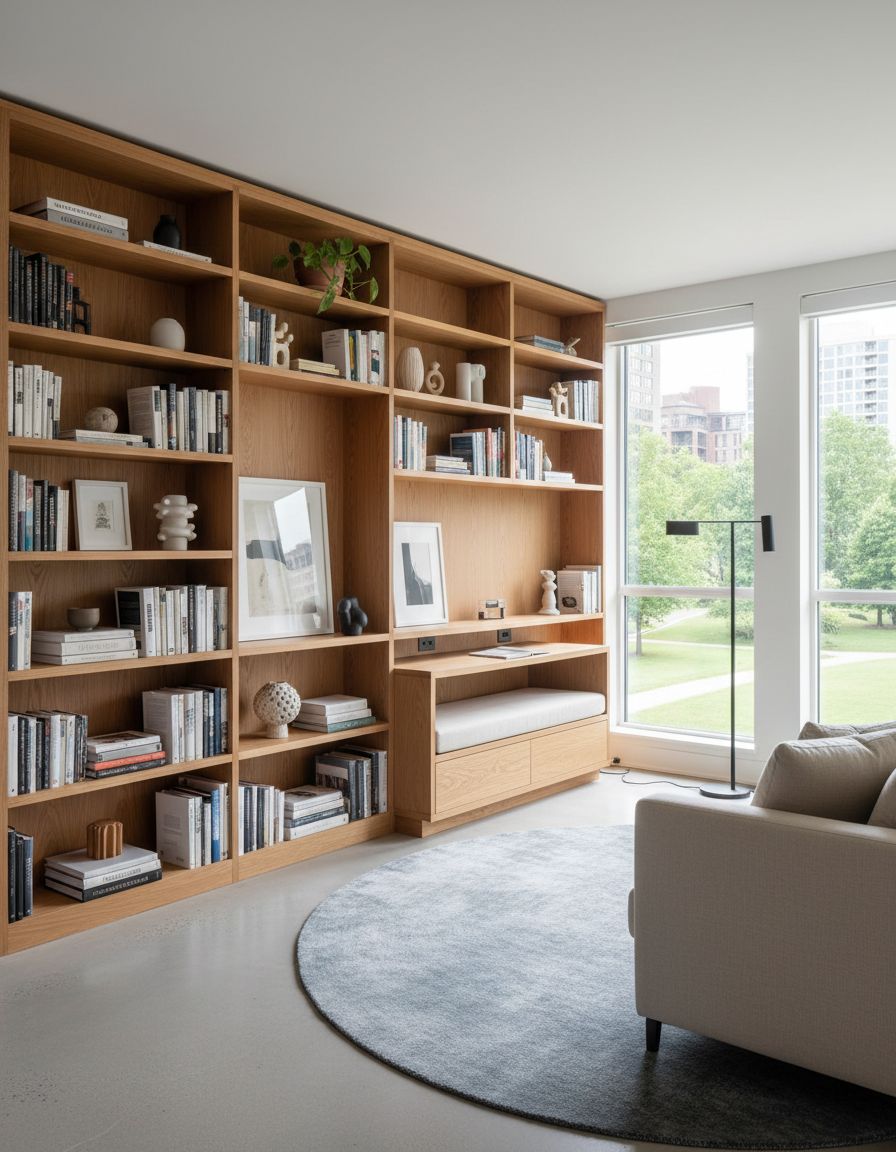
Innovative designs embedding storage within stairs, benches, or room dividers maximize functionality for space-constrained homes. These solutions demonstrate that book accommodation needn’t sacrifice square footage to dedicated shelving. Multi-purpose furniture reflects contemporary urban living realities while maintaining literary priorities, proving that even compact spaces can house substantial collections through creative thinking and custom solutions that serve multiple needs simultaneously.



